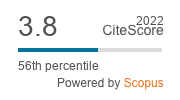Behaviors Coordination and Learning on Autonomous Navigation of Physical Robot
Abstract
Behaviors coordination is one of keypoints in behavior based robotics. Subsumption architecture and motor schema are example of their methods. In order to study their characteristics, experiments in physical robot are needed to be done. It can be concluded from experiment result that the first method gives quick, robust but non smooth response. Meanwhile the latter gives slower but smoother response and it is tending to reach target faster. Learning behavior improve robot’s performance in handling uncertainty. Q learning is popular reinforcement learning method that has been used in robot learning because it is simple, convergent and off policy. The learning rate of Q affects robot’s performance in learning phase. Q learning algorithm is implemented in subsumption architecture of physical robot. As the result, robot succeeds to do autonomous navigation task although it has some limitations in relation with sensor placement and characteristic.
Full Text:
PDFReferences
Nillson NJ. Shakey the Robot. AI Center. SRI International. Technical Note 323. 1984.
Brooks R. A Robust Layered Control System For a Mobile Robot. IEEE Journal of Robotics and Automation. 1986; 2(1): 14 – 23.
Arkin RC. Motor Schema Based Navigation for a Mobile Robot : an Approach to Programming by Behavior. IEEE Int. Conf. on Robotics and Automation. 1987: 264-271.
Arkin RC. Behavior-Based Robotics. England: Bradford Books. 1998.
Pirjanian P. Behavior coordination mechanisms: State-of-the-art. Univ. Southern California. Technical Report IRIS-99-375. 1999.
Sutton RS, Barto AG. Reinforcement Learning: an Introduction. Massachusets: MIT Press. 1998.
Erden MS, Leblebicoglu K. Free gait generation with reinforcement learning for a six-legged robot. Robotics and Autonomous Systems. 2008; 56 : pp.199–212.
Kroemer OB, Detry R, Piater J, Peters J. Combining active learning and reactive control for robot grasping. Robotics and Autonomous Systems. 2010; 58(10) : pp.1105–1116.
Watkins C, Dayan P. Q-learning: Technical Note. Machine Learning. 1992; 8: 279-292.
Perez MC. A Proposal of Behavior Based Control Architecture with Reinforcement Learning for an Autonomous Underwater Robot. Ph.D.Thesis. Girona: University of Girona; 2003.
Wicaksono H, Prihastono, Anam K, Kuswadi K, Effendie R, Jazidie A, Sulistijono IA, Sampei M. Modified Fuzzy Behavior Coordination for Autonomous Mobile Robot Navigation System. Proc. of ICCAS-SICE. Fukuoka. 2009.
Anam K., Kuswadi S. Behavior Based Control and Fuzzy Q-Learning For Autonomous Mobile Robot Navigation. Proceeding of The 4th International Conference on Information & Communication Technology and Systems (ICTS). Surabaya. 2008.
Knudosn M, Tumer K. Adaptive navigation for autonomous robots. Robotics and Autonomous Systems. 2011; 59 : 410-420.
Hohl L, Tellez R, Michel O, Ijspeert AJ. Aibo andWebots: Simulation, wireless remote control and controller transfer. Robotics and Autonomous Systems. 2006; 54(6): 472–485.
Oliveira G, Silva R, Lira T, Reis LP. Environment Mapping using the Lego Mindstorms NXT and leJOS NXJ. EPIA. 2009.
Benedettelli D., Ceccarelli N., Garulli A., Giannitrapani A. Experimental validation of collective circular motion for nonholonomic multi-vehicle systems. Robotics and Autonomous Systems. 2010; 58(8): 1028-1036.
Adriansyah A. Sebuah Model Berbasis Pengetahuan untuk Pengendalian Formasi Sistem Robot Majemuk. TELKOMNIKA Indonesian Journal of Electrical Engineering. 2010; 8(2): 81–86.
Djajadi A, Laoda F, Rusyadi R, Prajogo T, Sinaga M. A Model Vision of Sorting System Application Using Robotic Manipulator. TELKOMNIKA Indonesian Journal of Electrical Engineering. 2010; 8(2): 137–148.
Leffler BR, Mansley CR, Littman ML. Efficient Learning of Dynamics Models using Terrain Classification. Proceedings of the International Workshop on Evolutionary and Reinforcement Learning for Autonomous Robot Systems. 2008.
DOI: http://doi.org/10.12928/telkomnika.v9i3.738
Refbacks
- There are currently no refbacks.

This work is licensed under a Creative Commons Attribution-ShareAlike 4.0 International License.
TELKOMNIKA Telecommunication, Computing, Electronics and Control
ISSN: 1693-6930, e-ISSN: 2302-9293
Universitas Ahmad Dahlan, 4th Campus
Jl. Ringroad Selatan, Kragilan, Tamanan, Banguntapan, Bantul, Yogyakarta, Indonesia 55191
Phone: +62 (274) 563515, 511830, 379418, 371120
Fax: +62 274 564604

